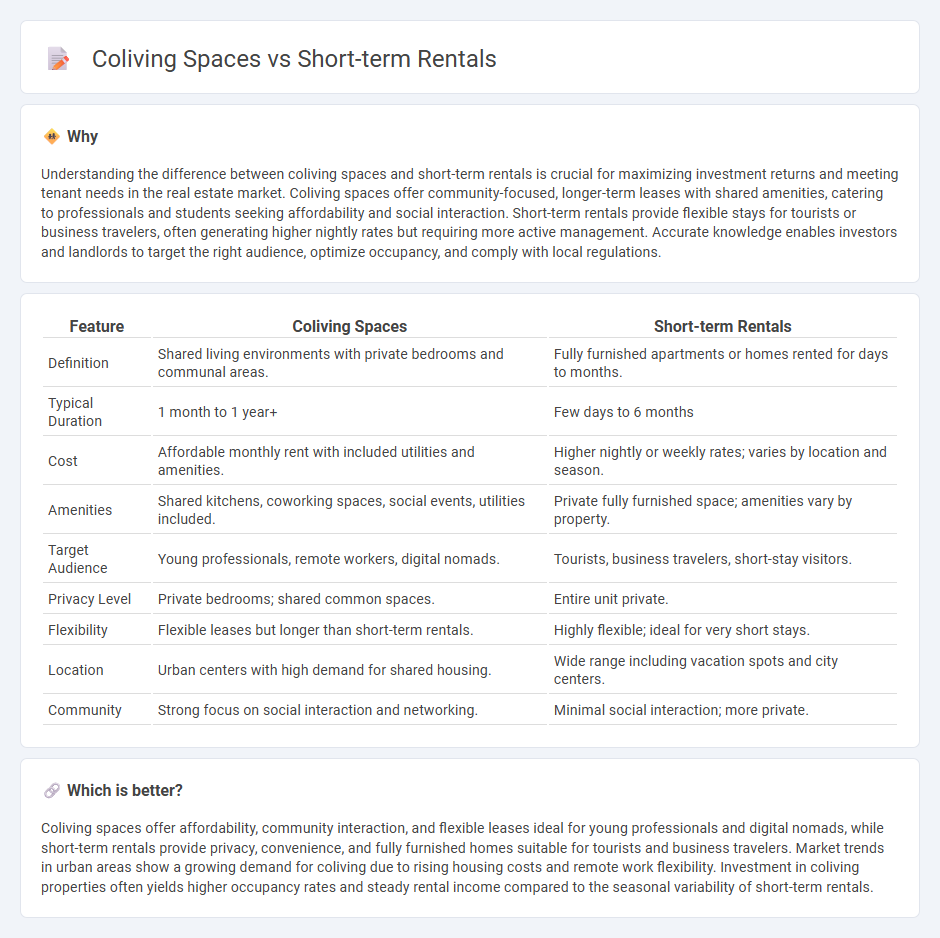
Coliving spaces offer a community-focused living arrangement with shared amenities and flexible leases, catering to remote workers and urban millennials seeking affordability and social interaction. Short-term rentals provide fully furnished properties for brief stays, appealing to travelers and business professionals needing convenience and privacy without long-term commitments. Explore the differences and benefits of these housing options to determine which suits your lifestyle and investment goals best.
Why it is important
Understanding the difference between coliving spaces and short-term rentals is crucial for maximizing investment returns and meeting tenant needs in the real estate market. Coliving spaces offer community-focused, longer-term leases with shared amenities, catering to professionals and students seeking affordability and social interaction. Short-term rentals provide flexible stays for tourists or business travelers, often generating higher nightly rates but requiring more active management. Accurate knowledge enables investors and landlords to target the right audience, optimize occupancy, and comply with local regulations.
Comparison Table
| Feature | Coliving Spaces | Short-term Rentals |
|---|---|---|
| Definition | Shared living environments with private bedrooms and communal areas. | Fully furnished apartments or homes rented for days to months. |
| Typical Duration | 1 month to 1 year+ | Few days to 6 months |
| Cost | Affordable monthly rent with included utilities and amenities. | Higher nightly or weekly rates; varies by location and season. |
| Amenities | Shared kitchens, coworking spaces, social events, utilities included. | Private fully furnished space; amenities vary by property. |
| Target Audience | Young professionals, remote workers, digital nomads. | Tourists, business travelers, short-stay visitors. |
| Privacy Level | Private bedrooms; shared common spaces. | Entire unit private. |
| Flexibility | Flexible leases but longer than short-term rentals. | Highly flexible; ideal for very short stays. |
| Location | Urban centers with high demand for shared housing. | Wide range including vacation spots and city centers. |
| Community | Strong focus on social interaction and networking. | Minimal social interaction; more private. |
Which is better?
Coliving spaces offer affordability, community interaction, and flexible leases ideal for young professionals and digital nomads, while short-term rentals provide privacy, convenience, and fully furnished homes suitable for tourists and business travelers. Market trends in urban areas show a growing demand for coliving due to rising housing costs and remote work flexibility. Investment in coliving properties often yields higher occupancy rates and steady rental income compared to the seasonal variability of short-term rentals.
Connection
Coliving spaces and short-term rentals both address the growing demand for flexible, affordable housing solutions in urban real estate markets. These models optimize space utilization by providing shared amenities and community-oriented living, appealing to remote workers and transient populations. By leveraging digital platforms for booking and community engagement, they contribute to evolving residential trends and increase property turnover rates.
Key Terms
Lease Agreement
Short-term rental lease agreements typically emphasize flexibility with shorter durations, allowing guests to book stays from a few days to several weeks, while coliving lease agreements often require longer commitments reflecting a shared living arrangement spanning months. Key elements in short-term rental contracts focus on occupancy limits, payment terms, and property rules, whereas coliving leases include clauses about communal responsibilities, shared amenities, and cohabitation guidelines. Explore detailed comparisons to understand which lease agreement aligns best with your lifestyle and rental needs.
Occupancy Rate
Short-term rentals typically experience fluctuating occupancy rates influenced by seasonal demand and local events, often averaging between 50-70% annually. Coliving spaces maintain more consistent occupancy, generally around 80-90%, due to longer lease terms and community-driven appeal. Explore detailed comparisons and strategies to maximize occupancy rates in both models.
Amenities
Short-term rentals often provide personalized amenities such as fully equipped kitchens, Wi-Fi, and entertainment systems catering to transient guests. Coliving spaces emphasize communal facilities like co-working areas, shared kitchens, and social lounges to foster community engagement among residents. Explore the differences in amenities to find the best living option suited to your lifestyle needs.
Source and External Links
Short Term Apartments For Rent in Charleston WV - Provides 47 flexible, furnished short-term apartments in Charleston, WV with leases typically no longer than six months and prices ranging from $697 to $1,738.
Charleston West Virginia Short-term Housing Rentals - Offers furnished short-term rentals in Charleston starting at $95/day with lease options ranging from 30 days to a year, including utilities and linens.
Short Term Rentals in Charleston, WV - Monthly, Weekly, ... - Lists 75 furnished short-term rentals in Charleston with a variety of property types, including apartments and houses, available for durations from nightly to six months or more, with amenities such as kitchens and laundry.
 dowidth.com
dowidth.com